
In this, our first catalog, we are delighted to present a variety of works that range from the early days of American
westward migration and expansion to mid-20th century modernist influence. Many have not been on the market in
decades, and we are delighted to offer them for sale. Among the highlights are a 1859 study painted by Albert Bierstadt
outside Laramie, Wyoming, on his first trip West. It is an extraordinary historical and artistic object. Franz Bischoff’s
The Watchman, Zion National Park was painted on this noted California impressionist’s only trip to Utah in 1928.
It captures the glorious quality of light the artist found at what is now the entrance to Zion National Park. LeConte
Stewart’s The Old Homestead brilliantly captures the poignancy and charm of a pioneer homestead, painted most likely
in his hometown of Kaysville, Utah in 1923. They join other captivating and diverse depictions of the American West,
especially of Utah.
It is an ideal time to collect 19th and early-to-mid 20th century American art. Prices have pulled back from the historic
highs of ten years ago. Buyers at many auction houses follow current trends favoring contemporary art. But, quality will
always prevail, and buying works of art by important artists, whether currently in favor or not, can bring lasting pleasure
and satisfaction. Since the inception of the gallery in 2014, it has been our goal to connect both new and experienced
collectors with great art of Utah and the West, and we believe this publication and exhibition furthers that goal.
I would like to thank Jennifer Klekas and Shawn Hansen for their production and design assistance with this catalog.
I look forward to seeing you in the gallery!
David
To request a catalog, please email info@daviddeefinearts.com
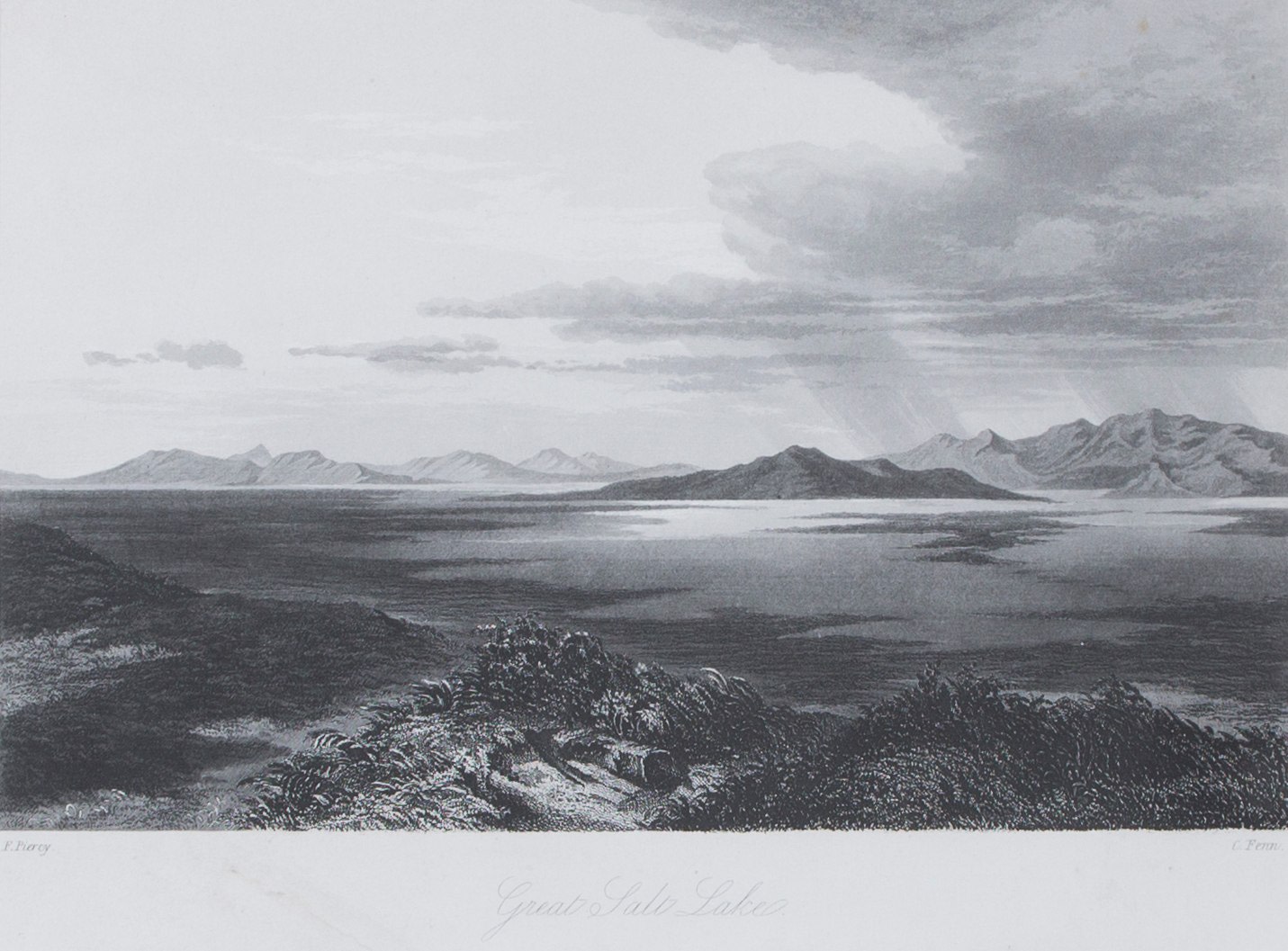
Frederick Hawkins Piercy (1830 - 1891)
The Great Salt Lake, 1855
Steel engravings
9 x 12 inches
In 1853, the 23-year-old British artist Frederick Piercy embarked on a journey to the Great Salt Lake Valley. He wrote, “My objectwas to make sketches of ... the Route, and Great Salt Lake City, which were afterwards to be published.” His aim was to provide crucial information to Mormon converts emigrating to the Rocky Mountains. In January 1854 Piercy returned to England, where Charles Fenn made Piercy’s sketches into high quality steel engravings. James Linforth, an editor for the LDS publication Millennial Star, added footnotes to Piercy’s 45 drawings, which became the illustrations for Route from Liverpool to Great Salt Lake Valley. From July 1854 to September 1855 it was published first in 15 parts, and then in full book form. Though its use was limited among Latter-Day Saint emigrants, who by then were using eastern seaports to avoid cholera in the New Orleans area, the book proved to be a valuable aid for historians of the West.
The gallery is offering three leaves from this important publication: The Great Salt Lake Valley; View of the Missouri River and Council Bluffs from an Elevation; and Loop
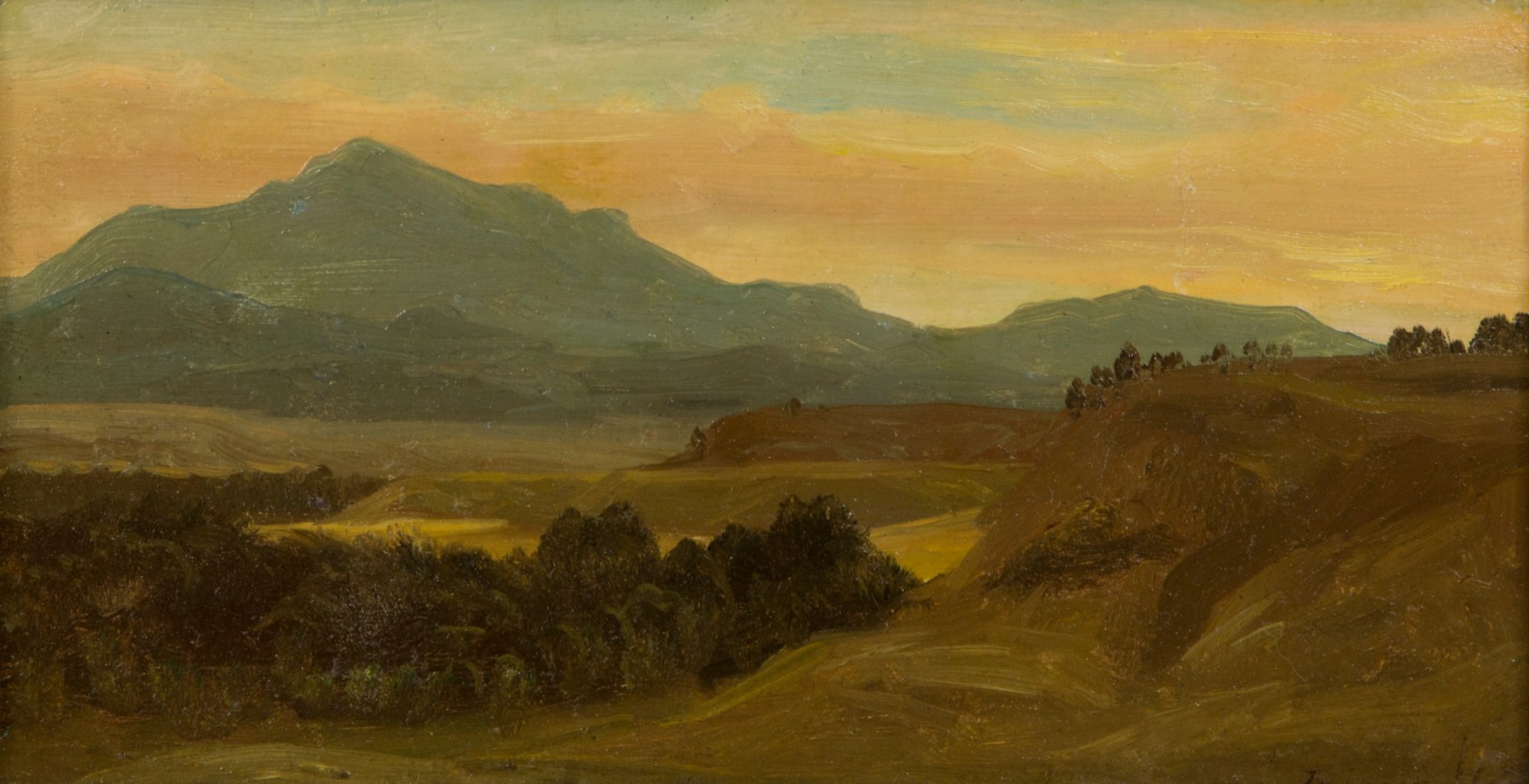
Albert Bierstadt (1830 - 1902)
Laramie Peak, 1859
Oil on canvas
5.375 x 9.75 inches
SOLD
Albert Bierstadt is best known today for his panoramic views of majestic mountains and cascading waterfalls in the American West. In the second half of the 19th century, his paintings awed and inspired Eastern audiences. The German-born Bierstadt’s first exposure to the West came in 1859 when he joined an expedition led by Colonel Frederick W. Lander on the Overland Trail. The trip, which took him through Kansas and Nebraska territories and as far West as the Rocky Mountains, led Bierstadt to his life’s work. This remarkable study was made by Bierstadt in 1859 as the Lander expedition camped on the Overland, or Oregon Trail east of Laramie, Wyoming. Extensive research and expert opinion has confirmed the painting and signature’s authenticity. It may have been assigned the title “Lawrence Peak” (inscribed on rear) out of confusion by a later owner.
Paintings by Bierstadt are in the collections of the National Gallery of Art, Washington, D. C.; Crocker Art Gallery, Sacramento; National Academy of Design, New York; Metropolitan Museum of Art, New York; St. Louis Art Museum; Museum of Fine Arts, Boston; Detroit Institute of Arts; Albright-Knox Art Gallery, Buffalo, New York; Fine Arts Museum of San Francisco; Virginia Museum of Fine Arts, Richmond and many more.
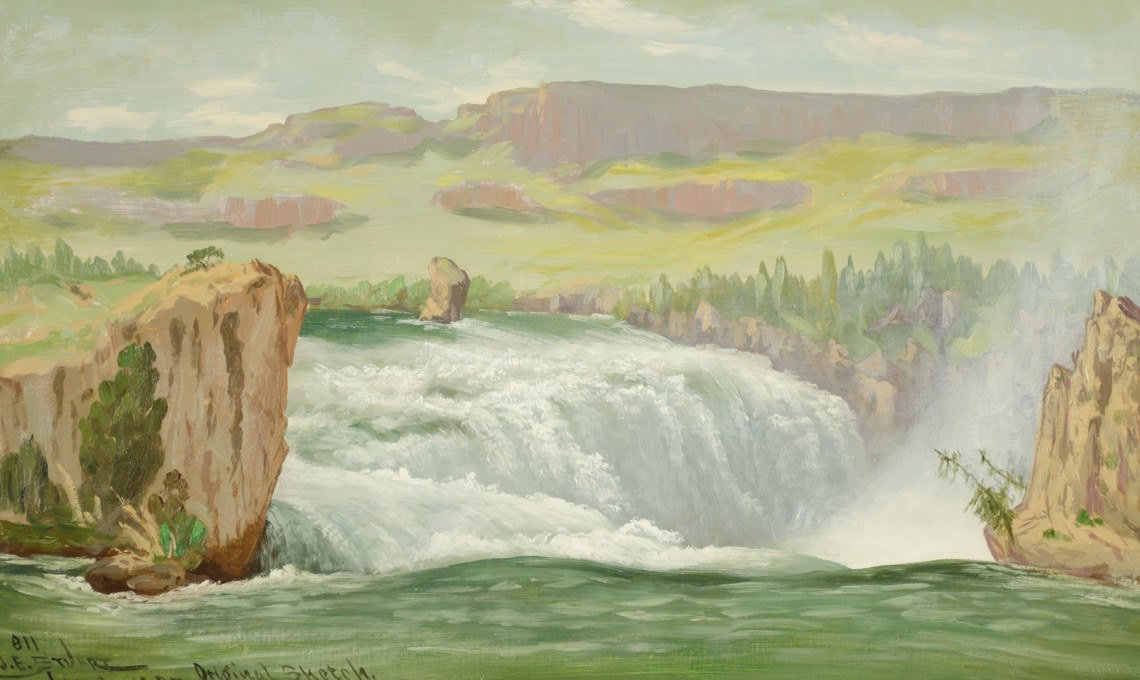
James Everett Stuart (1852 - 1941)
Looking Across the Top of Shoshone Falls, Idaho, June 21, 1885
18 x 30 inches
oil on canvas
One month prior to painting his energetic scene of geysers in Yellowstone, Stuart visited Shoshone Falls near Boise, Idaho. He deftly created a sense of motion, grandeur, and drama, depicting the mist from the falls rising hundreds of feet in the air. It was one of the many wonders that easterners were anxious to learn about through the art of painters like Stuart.
Biography:
Born in Bangor, Maine, James Everett Stuart became known for his panoramic landscapes throughout North America, but especially of the American West. His parents took him to California at the age of eight, and the family settled in San Francisco where he attended the public schools and studied art with Virgil Williams, Raymond Yelland, Thomas Hill, and William Keith at the San Francisco School of Design. In 1885, Stuart first went to Yellowstone where he camped for several weeks, supplied himself with fish for food, climbed steep cliffs including Electric Peak, and filled his sketchbook for studio paintings. The following summer, Stuart returned, having negotiated a free pass from the Northern Pacific Railroad in exchange for paintings. He spent the next several summers in Yellowstone, selling paintings from his tent.
Signed "J.E. Stuart" lower left, dated, titled and numbered
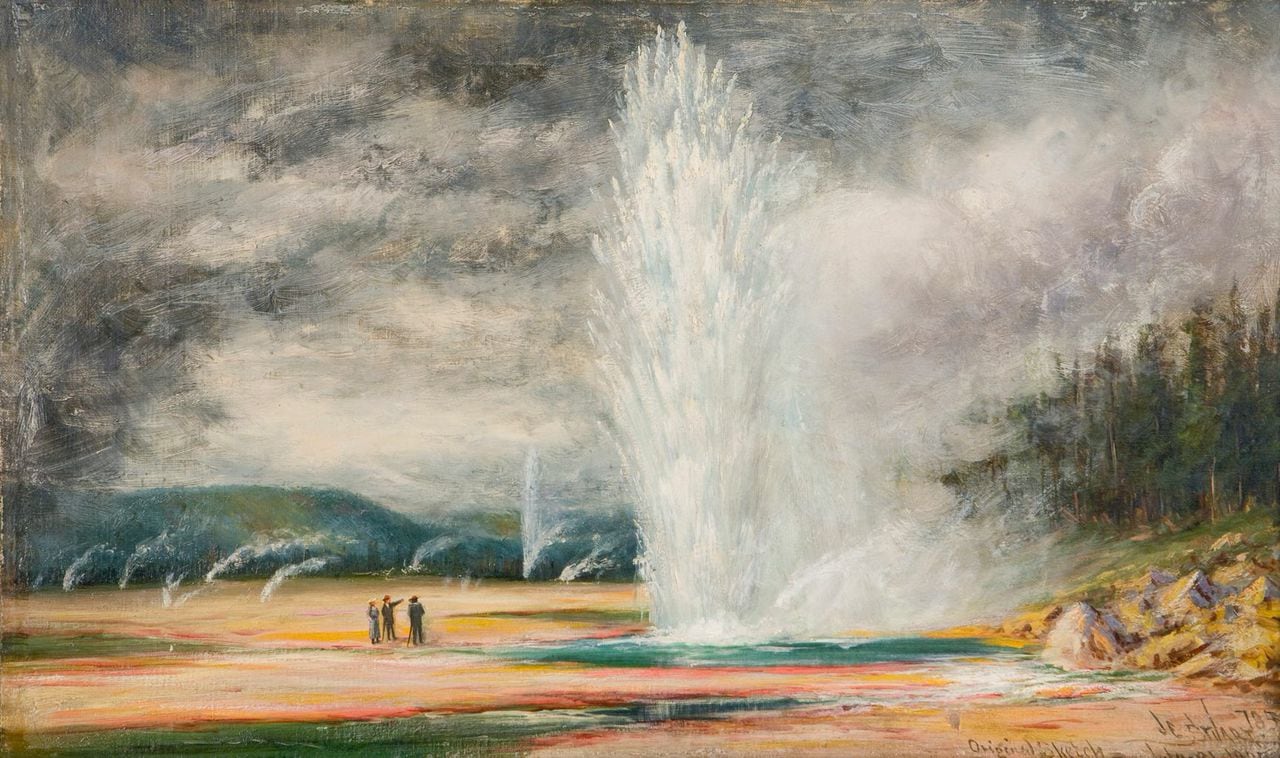
James Everett Stuart (1852 - 1941)
The Grand Geyser - Upper Geyser Basin Yellowstone, July, 1885
Oil on Canvas
18.25 x 30 inches
Fully immersed in the wonders of Yellowstone, Stuart captures the power, drama, and scale of the great curiosity that were Yellowstone’s geysers. The painting shows the scale of the geysers by employing figures pointing up to a dramatic eruption.
Selected Collections:
Buffalo Bill Center of the West
MOA at Brigham Young University
Crocker Art Museum
Oakland Museum of California
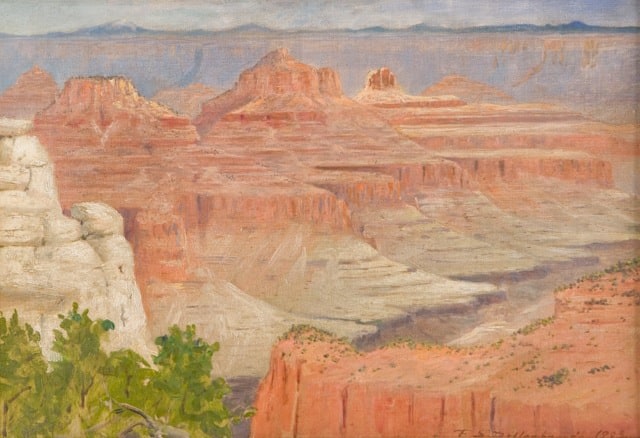
Frederick S. Dellebaugh (1853 - 1935)
The Grand Canyon
4 June, 1903
11 x 15 1/2 inches
Oil on canvas
SOLD
Ohio native Frederick S. Dellenbaugh received his artistic training at the Académie Julian in Paris under Jules-Joseph Lefebvre and Carlous-Duran. At just seventeen he was hired to accompany Major John Wesley Powell, on Powell’s second expedition exploring the Colorado River. Powell sought to map the entirety of the Colorado River and to collect geological information on the Colorado Plateau. Dellenbaugh was hired to assist in the making of maps and to paint features of the landscape that could not be easily photographed. Dellenbaugh, entranced with the country, returned to the Southwest and painted this geographically detailed view of the Grand Canyon in 1903.

Thomas Moran (1837 - 1926)
The Grand Canyon of Arizona (from Hermit Rim Road), 1912
Chromolithograph
24 x 32 inches
SOLD
Thomas Moran’s chromolithographs capture the grandeur and wonder of his watercolor paintings. Moran was involved in the production of the works, which involved a painstaking process which, due to its complexity and cost, went out of use in the 1920s. The Grand Canyon of Arizona (from Hermit Rim Road) captures the luminosity and sense of manifest destiny of the original painting.
Biography:
Long celebrated as the premier painter of Yellowstone and the Grand Canyon, Thomas Moran produced a remarkably varied body of work during a career that spanned more than sixty years. Extraordinarily adept at recognizing the “visual potential of newly discovered lands in the Far West,” Moran offered Americans and Europeans their first look at several spectacular sites later preserved as national parks.
Selected Collections:
Art Institute of Chicago
De Young Museum
National Gallery of Art, Washington DC
Cleveland Art Museum
Metropolitan Museum of Art
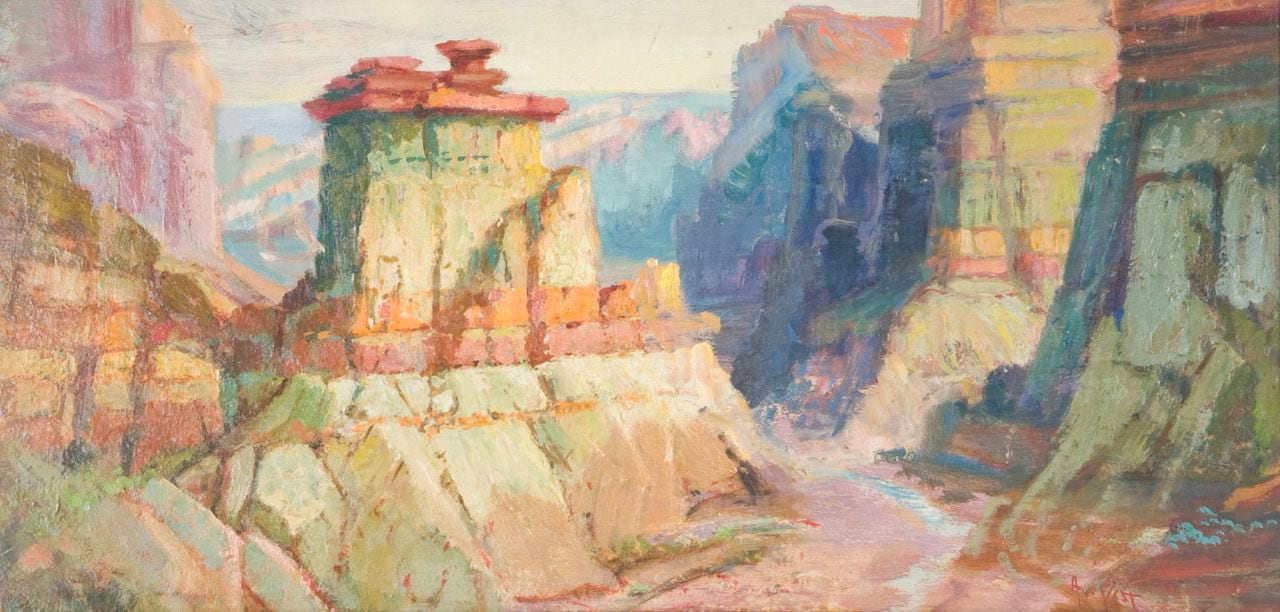
Arthur William Best (1859 - 1935)
Grand Canyon, circa early 1900's
10 x 20 inches
Oil on board
SOLD
A prominent early 20th-century Northern California landscape painter, Arthur Best was especially known for his paintings of the Grand Canyon, Arizona desert, and Sierra Nevada mountains. After opening an art school in San Francisco, Best became a staff artist for the San Francisco Examiner, and in 1904 did a series of Grand Canyon paintings. In 1905, he was commissioned by the Southern Pacific Railroad to paint pictures of the Southwest and Mexico. Best blended traditional, representational styles with bold, unorthodox coloration. In his Grand Canyon, he uses bright colors suggestive of modernism to depict the ancient rock formations. Signed lower right
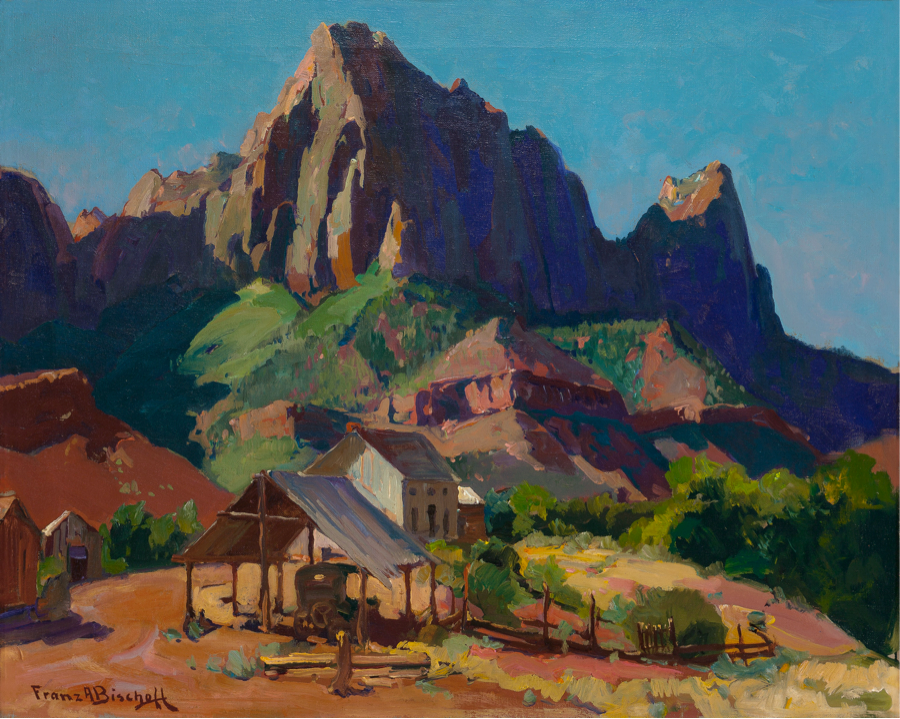
Franz Arthur Bischoff (1864 - 1929)
The Watchman, Zion National Park, Utah, 1928
Oil on canvas
24 x 30 inches
SOLD
Franz Albert Bischoff trained as a painter of fine ceramics and porcelain, which is reflected in the vibrant colors and expressive design of his masterful The Watchman, Zion National Park Utah. Painted in 1928, The Watchman exemplifies Bischoff’s postimpressionist, expressive use of color and highlighting. Painted near the modern-day entrance to Zion National Park, it captures a moment of peaceful majesty.
Signed lower left: Franz A Bischoff
Signed and titled verso: The Watchman / Zion Nat. Park / Utah / Franz A Bischoff
Signed on frame verso: FA Bischoff
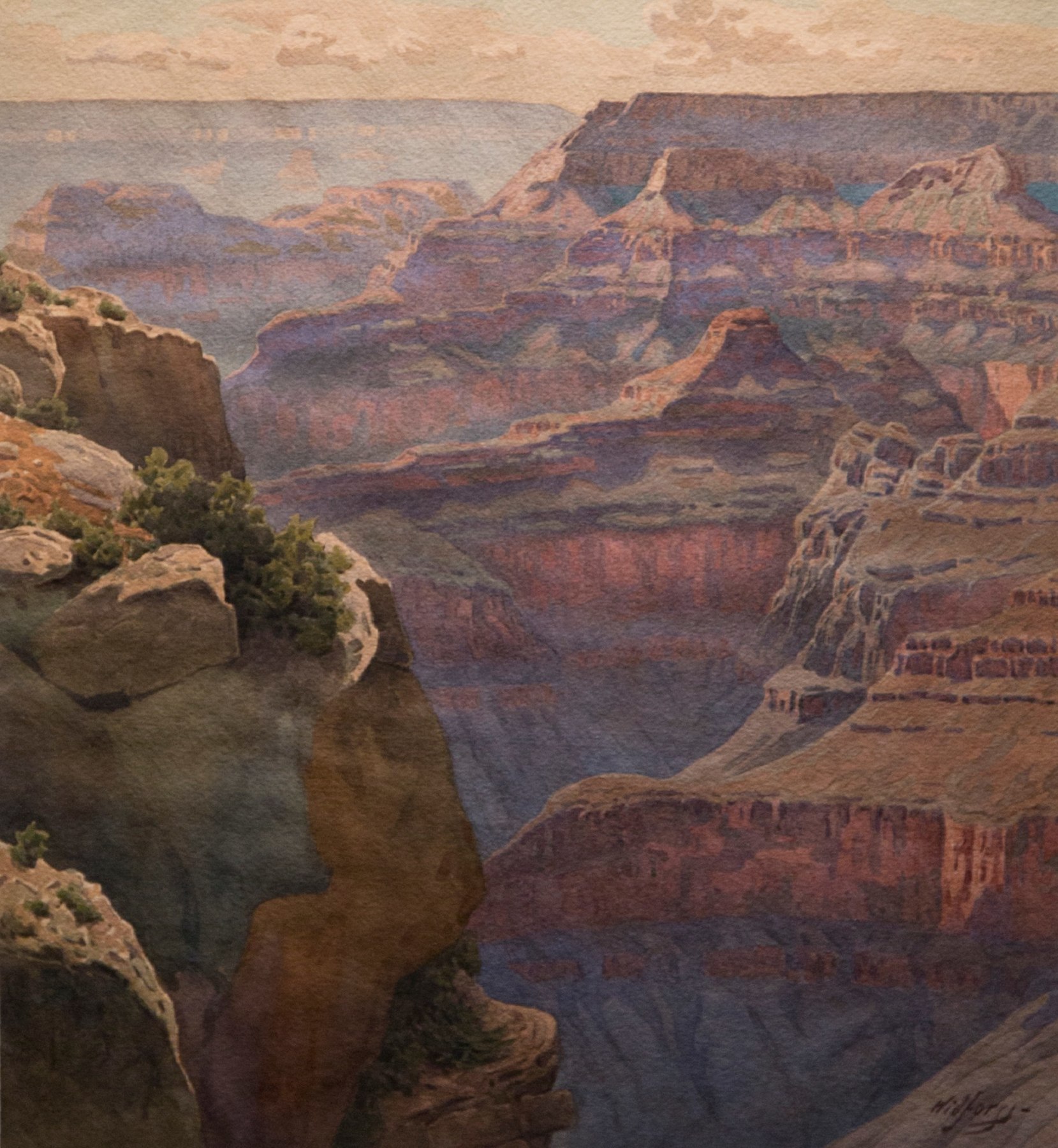
Gunnar Widforss (1879 - 1934)
View of the Hopi Point of the west rim of the Grand Canyon, circa 1920's
16 x 14 inches
watercolor on paper
SOLD
Perhaps no one painted the Grand Canyon more skillfully or compellingly than Gunnar Widforss. He first visited the Grand Canyon in 1923, and eventually made his home on the South Rim. Widforss exchanged paintings with the Fred Harvey Company for a room in one of the employee dormitories and meals at Bright Angel Lodge. The company exhibited his work in the lobby of the El Tovar Hotel. Widforss also made strenuous hikes into the Canyon in order to paint and would spend weeks at a time at Phantom Ranch. Grand Canyon photographer Emery Kolb recalled hiking with the artist to Plateau Point (thirteen miles round trip) each of the ten days that it took Widforss to complete one of his canvases. Preferring to work en plein air, Widforss worked indoors only on rare occasions and in a letter to a friend remarked that it is “much better to sit out in the middle of the scene.”
Signed lower right
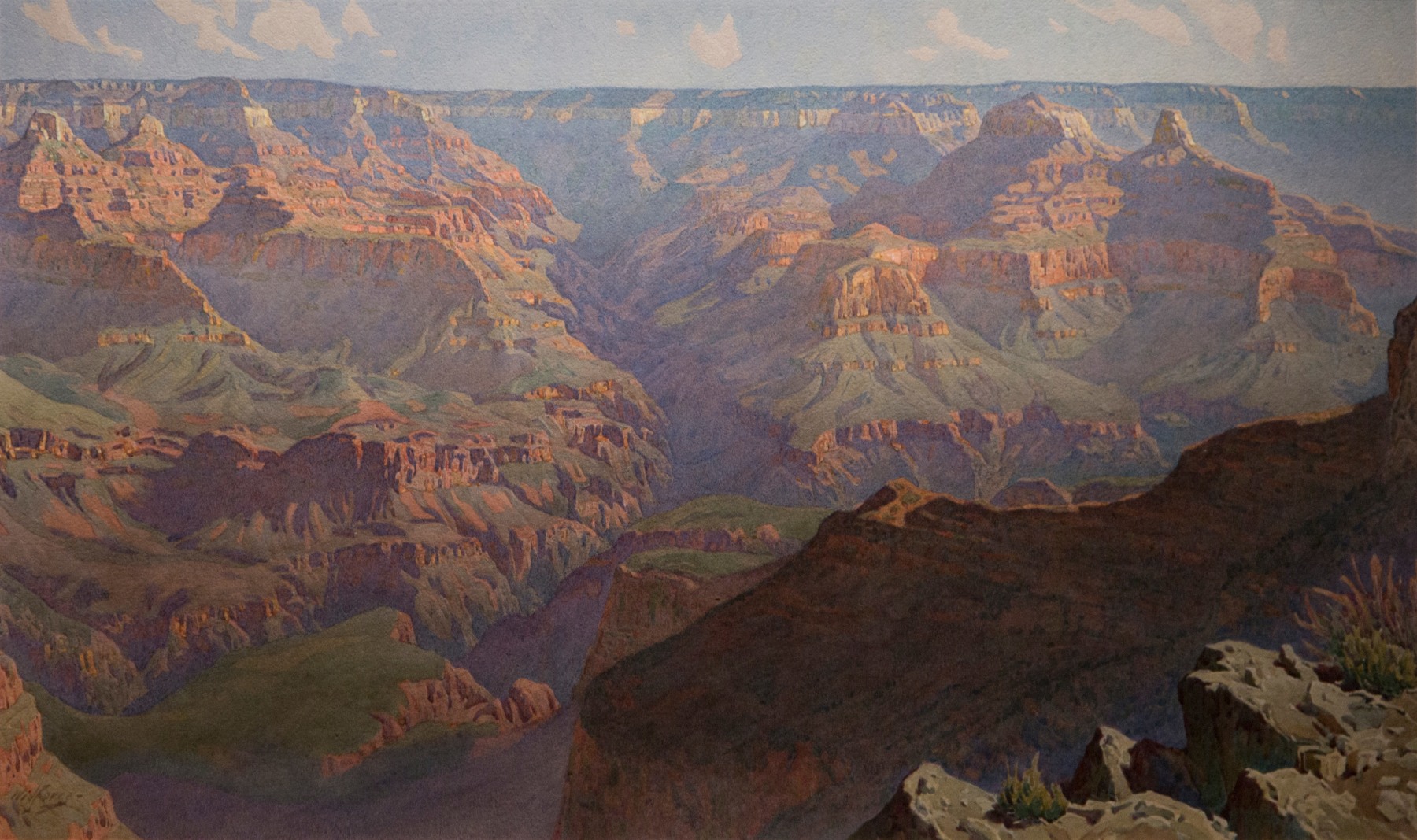
Gunnar Widforss (1879 - 1934)
Grand Canyon, circa 1920's
15.75 x 23.375 inches
Watercolor on paper
SOLD
Major museum exhibitions of Widforss’ work have been rare. The first was presented in December 1924 at the National Gallery of Art in Washington, D.C. The exhibit included 72 watercolors that primarily included scenes of western National parks. William Henry Holmes, the first Director of the National Gallery of Art in Washington. D. C., and an artist also known for his extraordinarily accurate drawings and watercolors, commented on Widforss’ Grand Canyon paintings in the exhibit. “They are remarkable as to geological construction and color. They give a more satisfactory understanding of the Grand Canyon than any that have hitherto been attempted. It is well nigh impossible to convey the immensity and grandeur of these marvels of nature but Widforss has accomplished it.” Holmes went on to say that “These are some of the finest things of their kind that have come out of the West.” Grand Canyon exemplifies Widforss working at his luminous best.
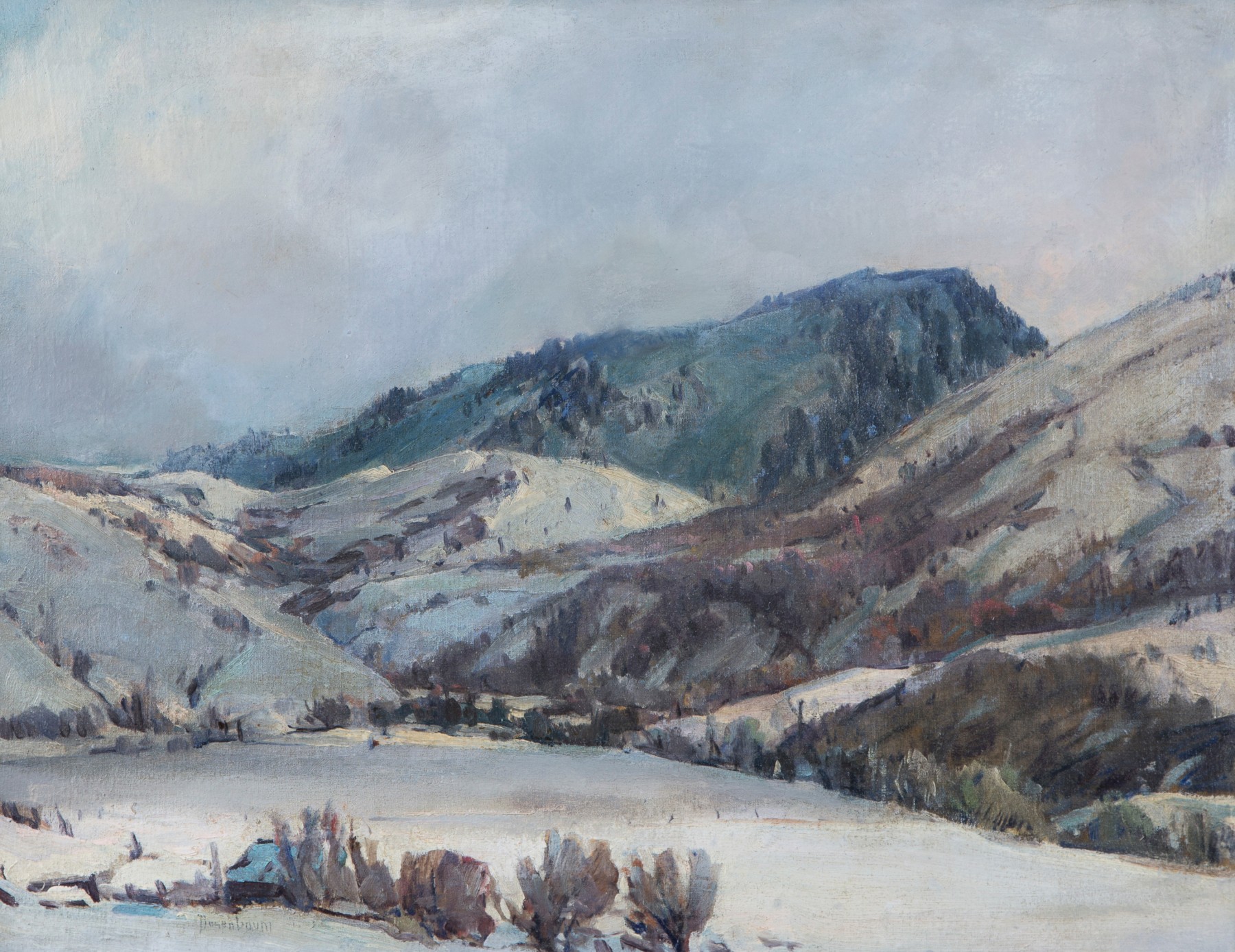
David Howell Rosenbaum (1908 - 1982)
Untitled (winter landscape), circa 1930’s
Oil on panel
22 x 28 inches
SOLD
Rosenbaum was one of Utah’s most enigmatic artists. While a student at Utah State Agricultural College, in Logan, Utah, he absorbed the influence of visiting artists Birger Sandzen, Ralph Stackpole, and Otis Oldfield. Several years later, in 1938 Rosenbaum made his way to the American Artists School and Art Students’ League in New York City for a year of structured training. He employed his modernist, expressive style into the paintings he produced during his time working for the WPA. After a tour of duty in WWII, Rosenbaum gradually became withdrawn and quit painting altogether. His landscape and genre paintings, such as this winter landscape, demonstrate his lyrical, tonal painting style at its best.

David Howell Rosenbaum (1908-1982)
January Snow, Circa 1930’s
Oil on canvas
28 x 32.5 inches
SOLD
At the height of the depression in 1931, David Howell Rosenbaum studied with Calvin Fletcher at Utah State Agricultural College. He became part of a group of artists who embraced Fletcher’s modernist impulses, with emphasis on bold colors, flattened picture planes, and a move toward abstraction. This coincided with the WPA Federal Arts Project, during which Rosenbaum painted some of his best works. He was one of Utah’s most expressive painters and created dynamic, well-designed compositions such as this one.
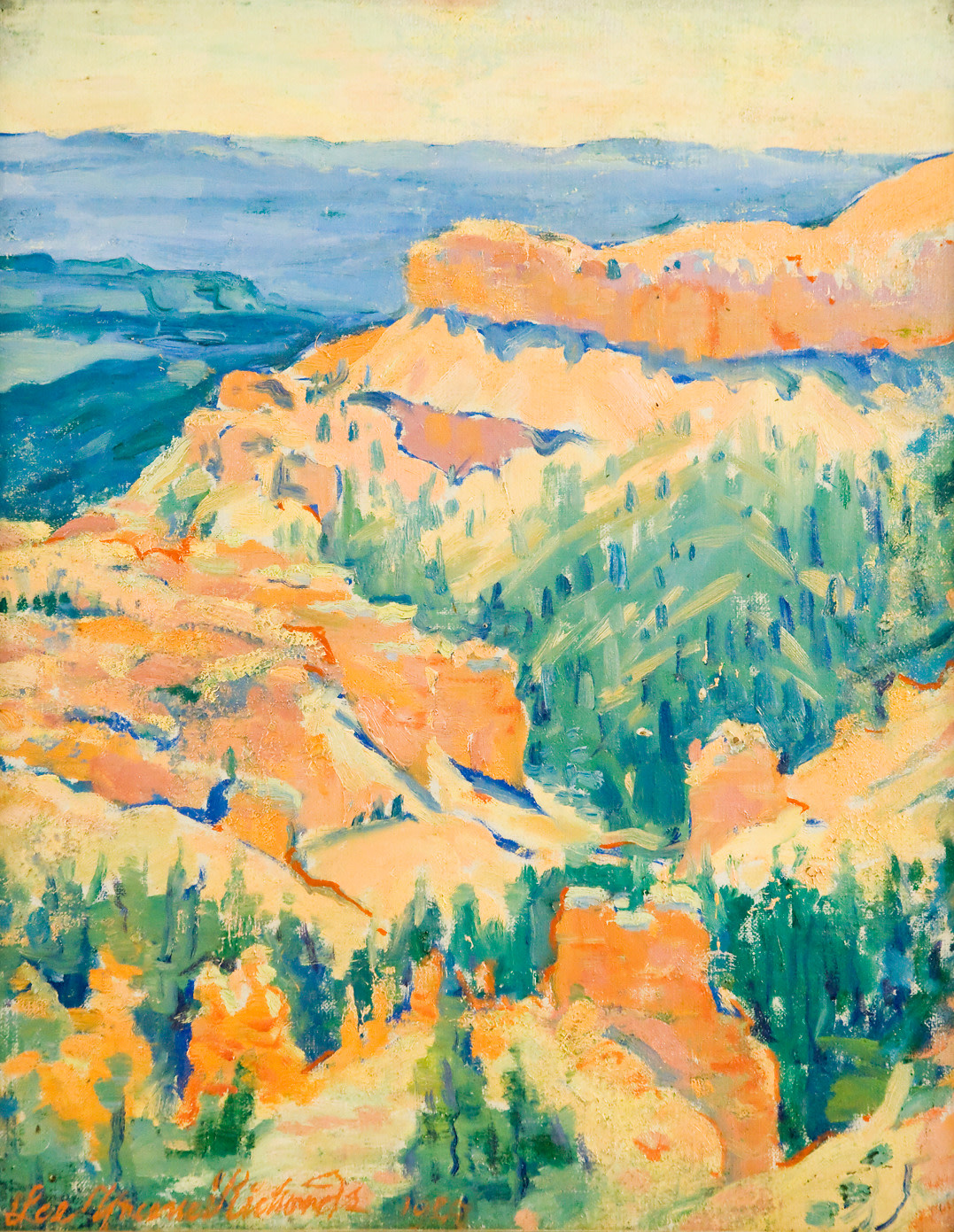
Lee Greene Richards (1878 - 1950)
Bryce Canyon, 1928
18 x 13 inches
Oil on canvas
SOLD
Lee Greene Richards has been celebrated as one of Utah’s most significant artists. Trained at both the Academie Julian and the Ecole des Beaux-Arts in Paris just after the turn of the 20th century, Richards was an integral part of the cohort of Utah-based artists that included Mahonri Young, A.B. Wright, and John Willard Clawson. It may have been Richards’ frequent visits to and residencies in Paris that influenced his painting of Bryce Canyon. Art historians Donna Poulton and Vern Swanson assert that, “As a landscape painter, Richards unleashed a fury of Impressionistic brushwork and Fauvisthues…While his contributions to red-rock genre were few, they are significant. He might be the first artist to paint a semi-modern view of Bryce Canyon.” (Painters of Utah’s Canyons and Deserts, p. 56) Richards’ Bryce Canyon is one of only a few to come on the market in recent years. It captures an era of fresh, modernist interpretation of the American Southwest, marking an important transition from the era of Romanticism embodied by Thomas Moran and others.
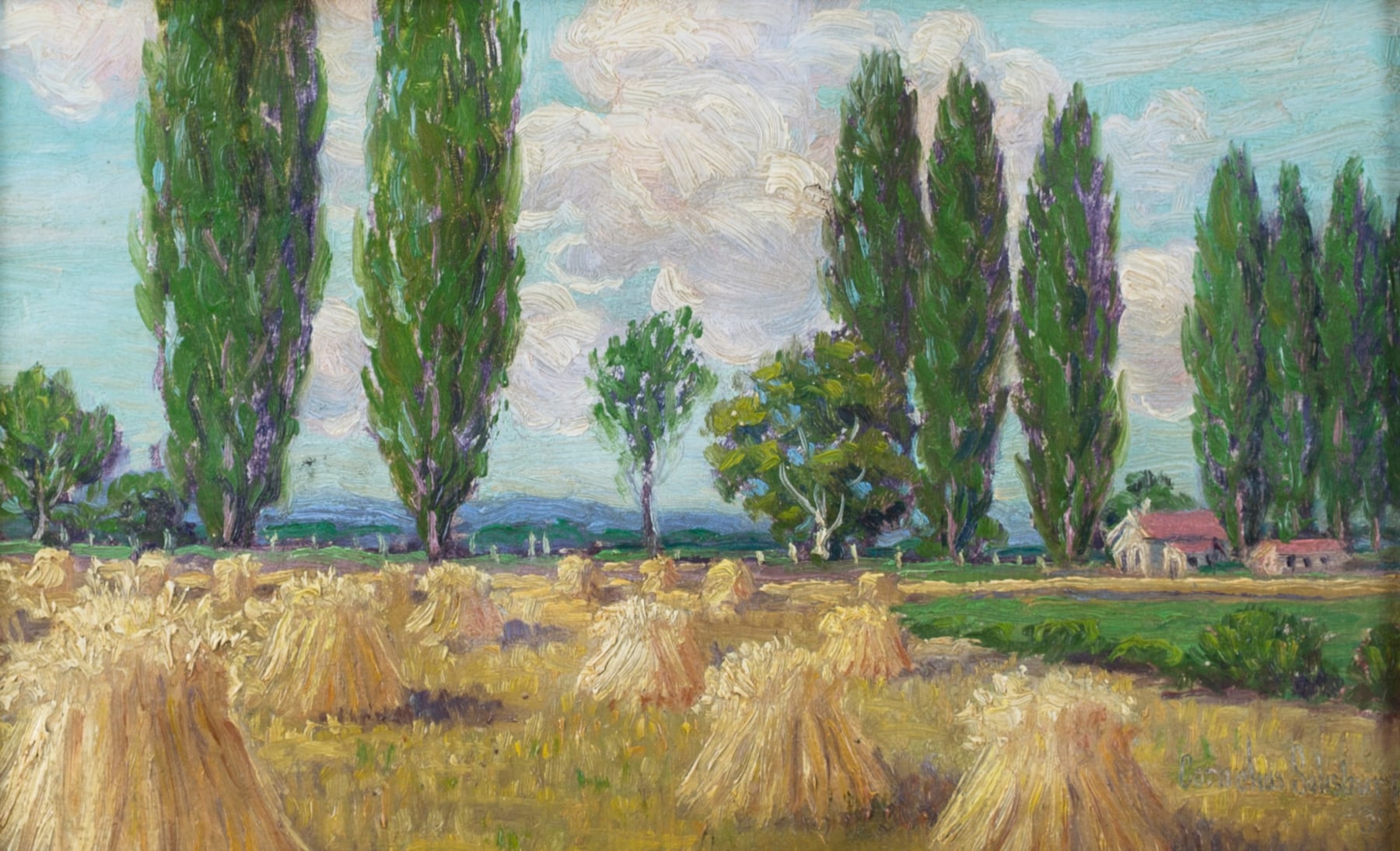
Cornelius Salisbury (1882 - 1970)
Late Summer, 1930
Oil on panel
10 x 16 inches
SOLD
Cornelius Salisbury studied with some of the most influential teachers of his day, including William Dufner at the Art Students League, in New York City, and instructors at the Corcoran Gallery in Washington, D.C., and at the Broadmoor Art Academy in Colorado Springs. This scene reflects the representational, Barbizon style he employed to celebrate the mostly rural Utah landscape of the early 20th century.

Waldo Midgley (1888 - 1986)
Untitled (Scene of barn and cart), circa 1930’s
Oil on canvas
16 x 20 inches
SOLD
Waldo Midgley, though born in Salt Lake City, spent most of his productive artistic life in New York City and felt most at home there. He arrived in 1907 and gravitated toward members of The Eight, all of whom later became members of the Ashcan School. He received important instruction from Robert Henri, and became friends and colleagues with Arthur Davies, William Glackens, Ernest Lawson, John Sloan and other significant American artists of the time.
As art historian Donna Poulton noted, Midgley became part of an approach to art that, “rejected the constrained conservatism of the National Academy of Design in favor of art that expressed forceful themes and rich subject matter, and that captured the excitement of New York scenes and people.”
In this untitled painting, executed on one of Midgley’s visits back home to Utah, he uses thick impasto and impassioned brush strokes to convey a sense of immediacy and energy. It has a modernist sensibility that would have clashed with the popular romantic, realist style popular in Utah at the time, but reflect the fast pace of change in the early 20th century.

L. Maynard Dixon (1875 - 1946)
Little Home Carson, Nevada, 1937
14 x 10 inches
Oil on board
SOLD
In “Little Home” Dixon celebrates the tenacious grit of the homesteaders of the American West. The small but sturdy home sits alone in a barren landscape, yet has its own dignity and beauty. It is protected by a mature Lombardy Poplar, a tree popular among the pioneer settlers of Utah and Nevada. The radiant blue sky is characteristic of Dixon’s best work and represents his admiration for the great expanse of the West.
Biography:
Maynard Dixon was an American painter, muralist and illustrator who was born on a ranch near Fresno, California. Frail health restricted his childhood amusements to sketching trips with his pony, reading and listening to the local old-timers’ tales of the early West. By the time he was sixteen, he had sufficient confidence in his work to send his sketchbook to Frederic Remington, his illustrator hero, who replied with two encouraging letters. At eighteen, spurred on by the encouragement and advice of Remington, he enrolled in the San Francisco School of Design and enjoyed a career as a successful illustrator before turning to painting full-time. Through a lifetime of extensive trips through the West and the insights they produced, he evolved a mastery of his material and a highly distinctive style— the architectural structuring of bold masses combined with dynamic composition and vibrant coloring.
Selected Collectiions:
Buffalo Bill Center of the West
De Young Museum
Metropolitan Museum of Art
National Museum of American Art – Smithsonian
Utah Museum of Fine Arts
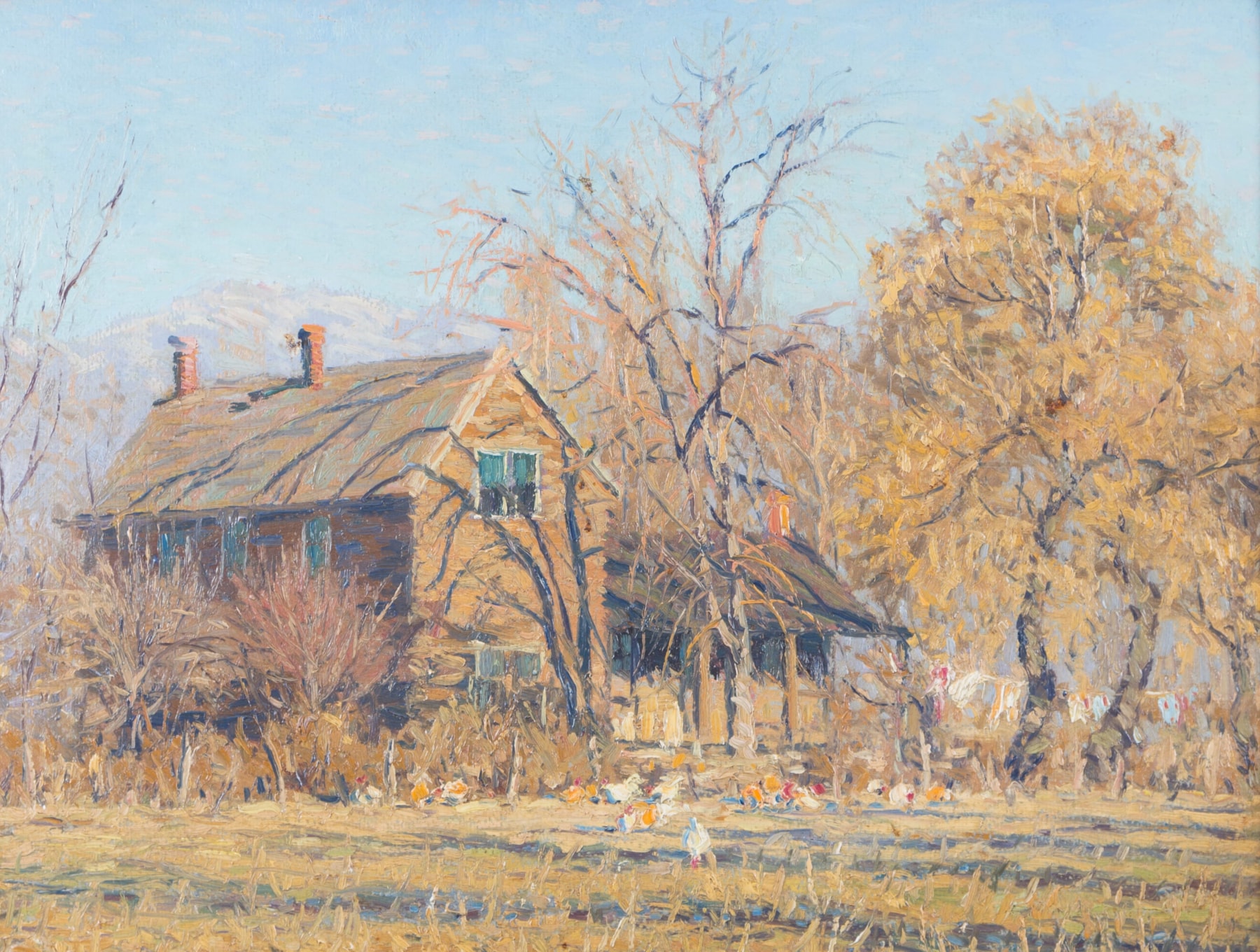
LeConte Stewart (1891-1990)
The Old Homestead, 1923
Oil on board
18 x 24 inches
SOLD
By the 1920s, Stewart had consolidated his various instructors’ influences and developed his own style that employed thick paint and vigorous, confident brushwork. He created representational, unidealized depictions of the world that he saw being swallowed up by development. In The Old Homestead, Stewart depicts a drab day in November that nevertheless shows the dignity of rural Utah farm life.
Biography:
LeConte Stewart was born in 1891 in Glenwood, Utah. His extensive art education began with study in 1912 at the University of Utah with Edwin Evans and private instruction with A.B. Wright. From 1913 through 1914 he attended the Art Students League summer school at Woodstock, New York where he studied with John F. Carlson and Walter Goltz. He later attended the Pennsylvania Academy of Fine Arts in Chester Springs.
During his art study, Stewart pursued a teaching career, starting in 1911 when he became an elementary teacher in the Murray City Schools. He then taught in several Utah school districts including Davis County, Salt Lake, and Ogden. He left Ogden Senior High School to become chairman of the Art Department at the University of Utah in Salt Lake City, where he retired in 1956 as professor emeritus.
LeConte Stewart mainly painted oil landscapes, which he usually painted quickly, on-site. He is predominantly known for his unidealized paintings of rural Utah; but he was also very productive in portraiture, mural painting, drawing, etching, lithography, pastel, and design.
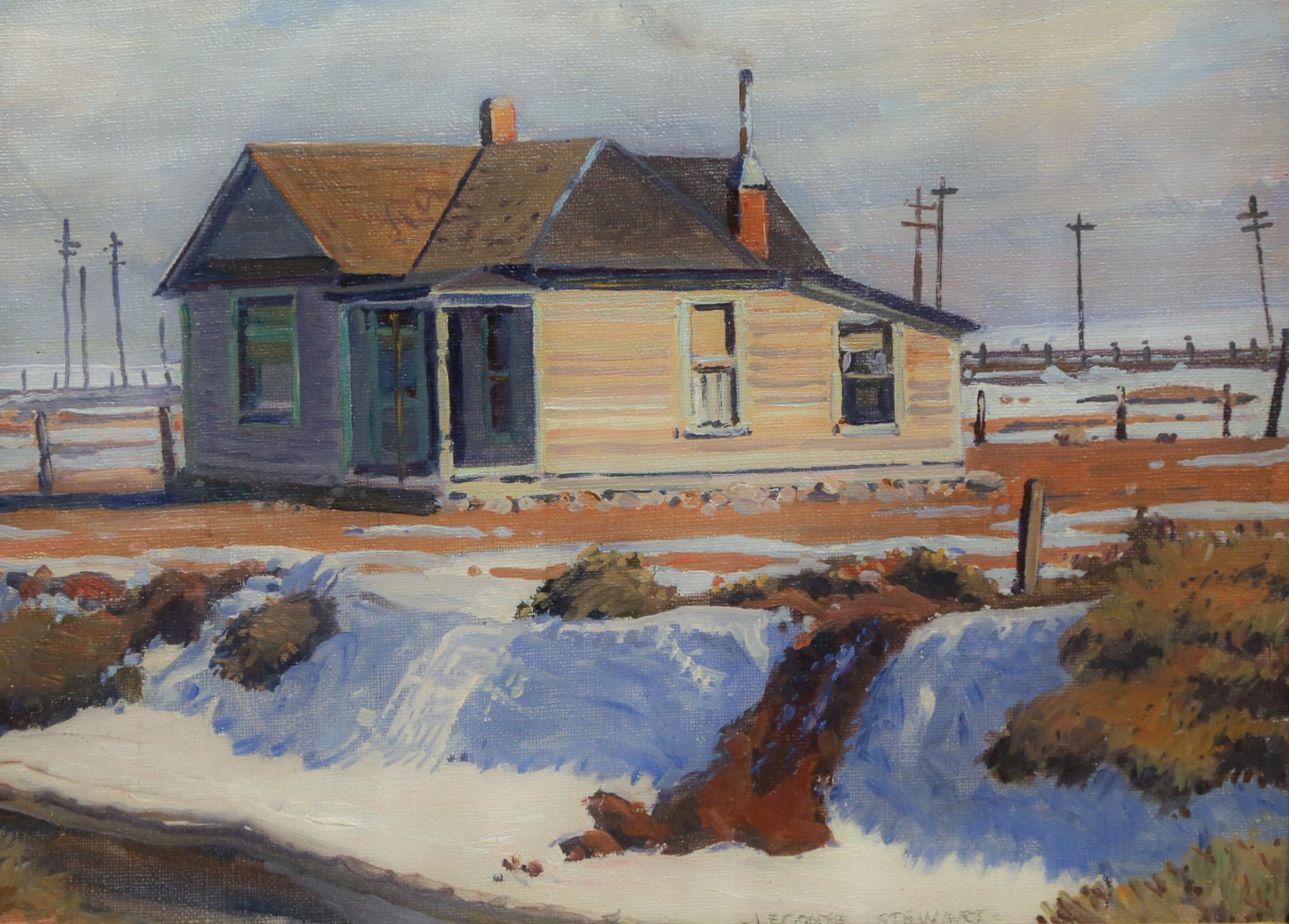
LeConte Stewart (1891 - 1990)
Untitled, (house on asmall bluff), c. 1930's
Oil on canvas
12 x 16 inches
SOLD
LeConte Stewart, in looking back on his output in the 1930s, once remarked that, “I had a period of five to eight years which had to do with very ordinary matters...things such as we see along the highways and byways. Stewart saw dignity in the ordinary, such as this house on a bluff, and the rural life it represented. He refused to sanitize a scene by taking out modern elements, such as power poles and lines; he also didn’t hesitate to take artistic license by arranging elements to create a successful composition.
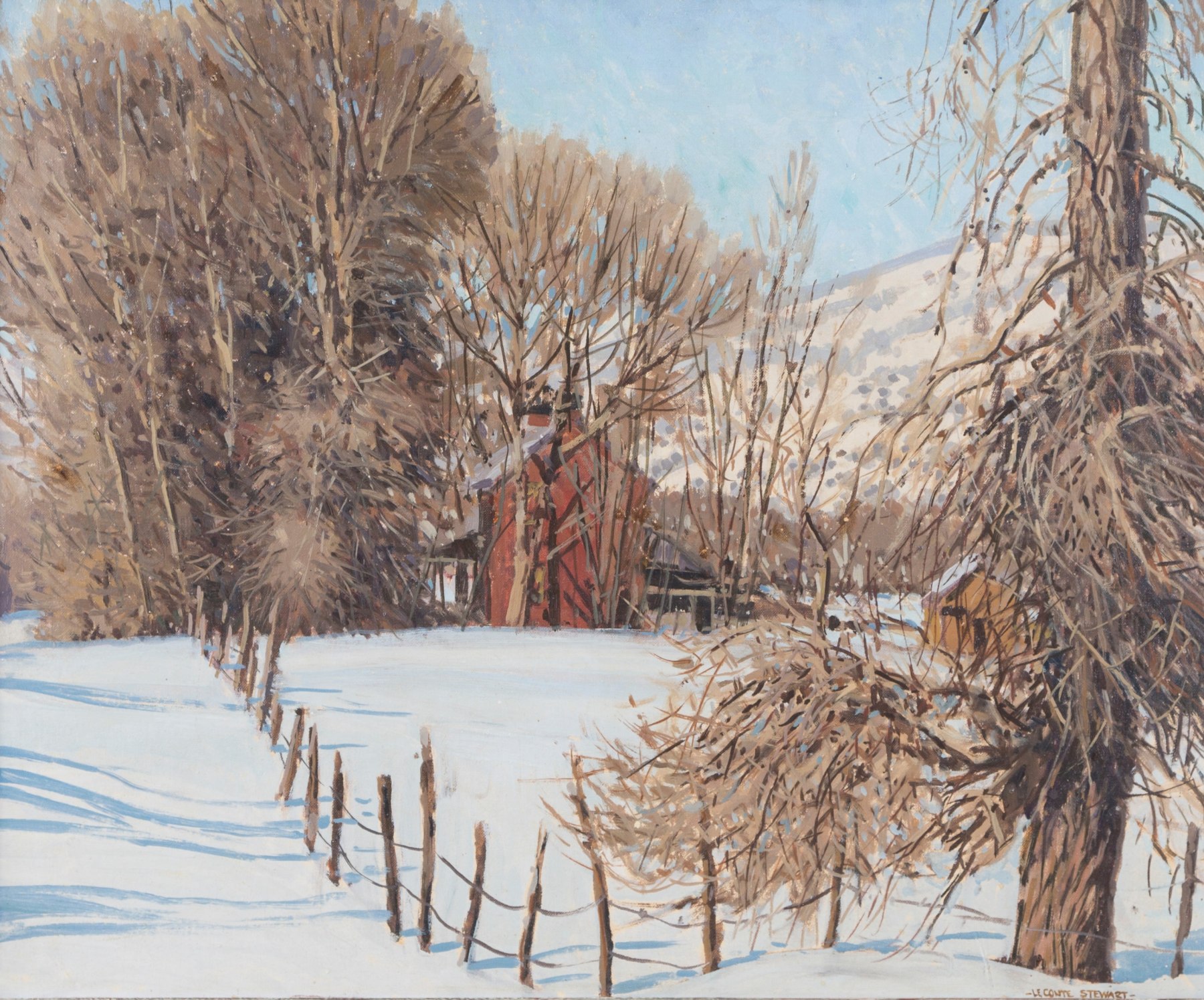
LeConte Stewart (1891 - 1990)
Untitled (farmhouse scene
with snow), 1949
Oil on board
20 x 24 inches
SOLD
LeConte Stewart told author Mary Muir that as a young boy, he often traveled with his lawyer father to neighboring towns. Already an aspiring artist and inveterate sketcher, he saw barns, sheds and houses in various states of repair. Writes Muir, “With these memories he experienced a peculiar isolation, an indescribable loneliness, (Stewart told her), ‘which all my life I have yearned to put down in paint.’”
By this point in his career, Stewart was at the height of his compositional skills. The craggy tree on the right anchors that side of the scene, and the deftly painted, rickety fence leads our eyes into the heart of the image: an old barn and farmhouse nestled in trees. Though it’s winter and the trees are bare, the striking, blue tones which characterizes many of Stewart’s beloved winter scenes mitigate the loneliness of the moment.

LeConte Stewart (1891 - 1990)
Colton, circa 1930’s
Oil on canvas
12 x 15.5 inches
SOLD
Perhaps the most beloved of all historical Utah painters, LeConte Stewart had a hardscrabble childhood in rural, central Utah. He developed a love for the land and a work ethic that led him to paint almost every day of his long life. At age 20, he went to New York state to train at the Art Students League in Manhattan and the Woodstock Art School in Woodstock, New York. Among his teachers were John F. Carlson, Ernest Blumenschein and Walter Goltz.
He later attended the Pennsylvania Academy of Fine Arts in Chester Springs. Stewart enjoyed a long career as a high school and university art instructor in Utah, but he is best know for his honest, tonal-impressionist scenes of Utah landscapes as well as his American scene paintings of the 1930s and 40s. In Colton, Stewart found beauty in the rugged, gritty existence of the rural rancher’s life.
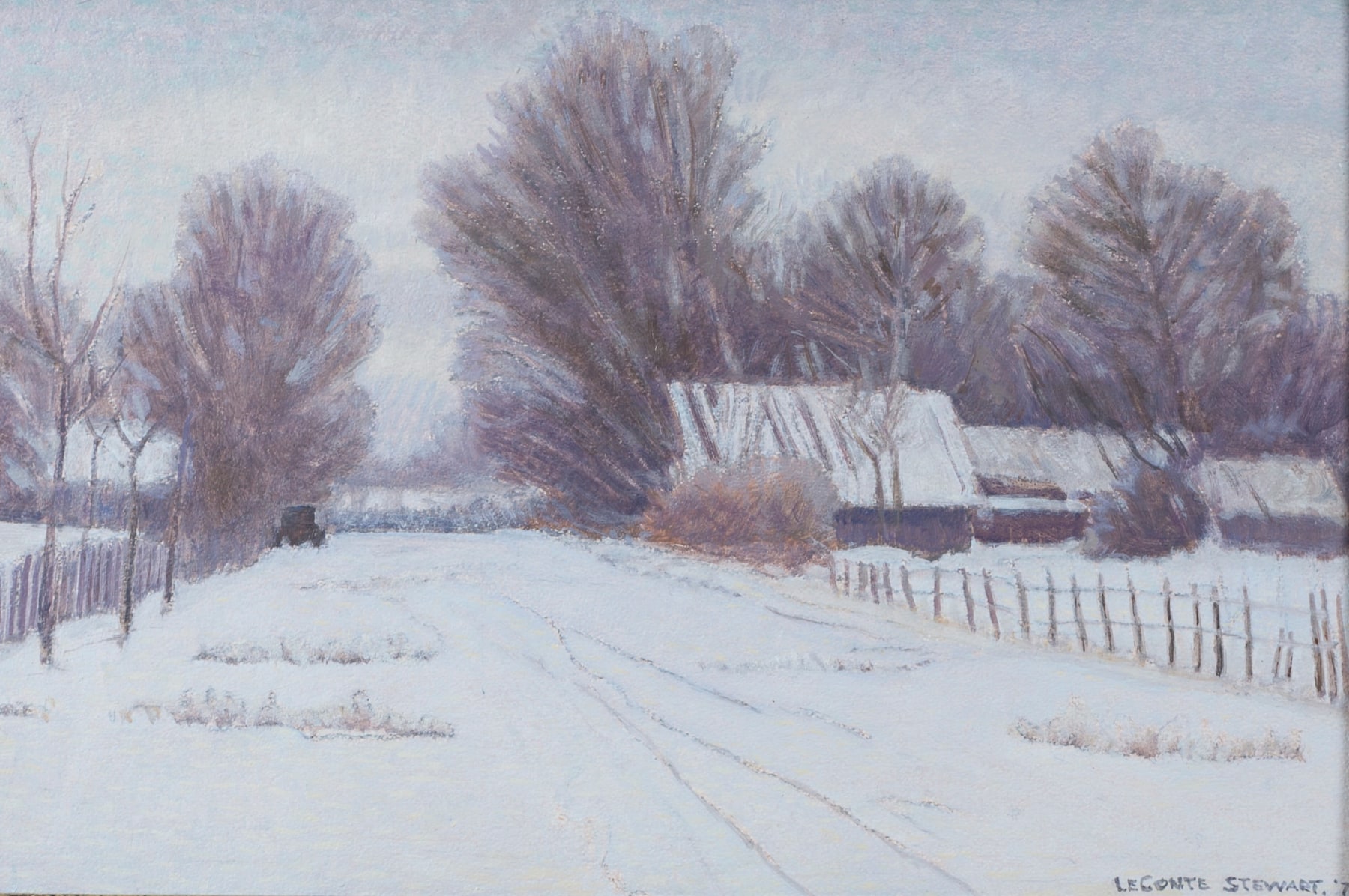
LeConte Stewart (1891 - 1990)
Untitled, (scene with road and farmhouse), 1978
Oil on canvas
12 x 18 inches
SOLD
In his later career, Stewart revisited some earlier themes and scenes, with a modified painting technique that included thinner paint application. His insistence on painting scenes that moved him, often with a road leading the viewer into the picture, remained. Even on the coldest winter days, he could be seen on the side of the road with his easel set-up, striving to capture a certain mood.
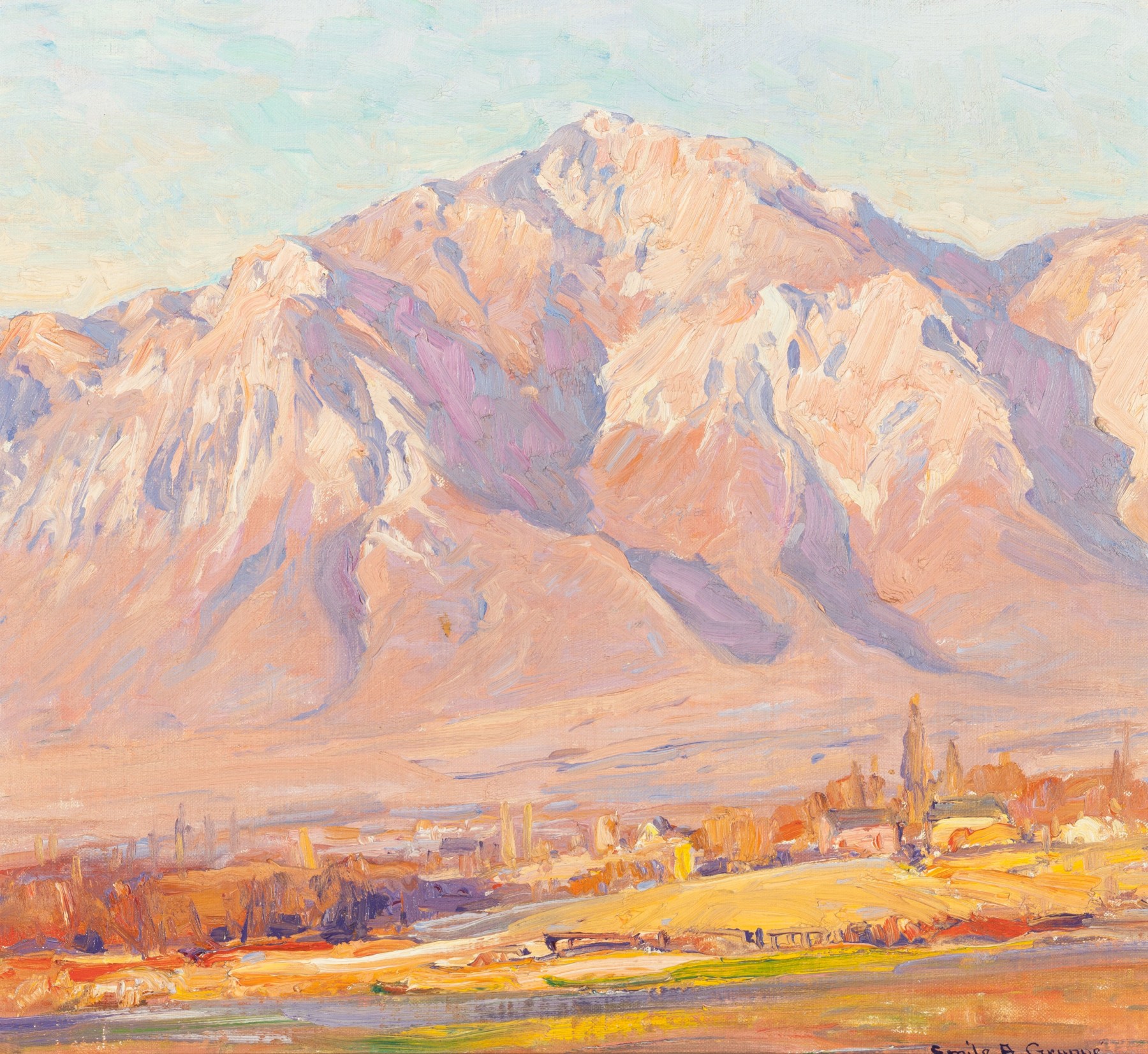
Emile A. Gruppe (1896 - 1978)
Ben Lomond, Utah, circa 1930s
Oil on artist’s board
18 x 20 inches
SOLD
A prolific artist and an influential teacher, Emile Gruppé enjoyed a long and successful career that spanned over six decades. Best known for his vigorous portrayals of the harbors and houses of Gloucester, Massachusetts and the rural scenery of Vermont, his art reflects his belief that “When a man paints, he expresses his whole life; what he’s done and what he’s experienced. If you are bold and outgoing, your work will show it.” Gruppe studied under John F. Carlson in Woodstock, New York, where a life-long friendship with Utah artist and fellow student LeConte Stewart began. Gruppé later stated that, “it was John Carlson who turned me into a painter,” teaching to him to see all “the pictorial possibilities of a subject.” Like Stewart, he incorporated Carlson’s impressionist methods into his own painting style. It was likely during a 1930 visit to Ogden, Utah that he painted this late afternoon view of Mount Ben Lomond.

Olaf Wieghorst (1899 - 1988)
Glacier National Park, Montana, ca. 1946
oil on canvas
20 x 24 inches
SOLD
Danish-born Olaf Wieghorst emigrated to the United States, where he eventually became known as the “Dean of Western Artists.” Before achieving fame as an artist, Wieghorst worked as an acrobat, trick rider, cavalryman, cowboy, and mounted policeman. In 1940, Wieghorst found an agent who immediately sold his paintings as calendar art and Western illlustrations, and by 1942, he was receiving commissions for horse portraits and bronzes. On his only trip to Glacier National Park in 1946, Wieghorst captured its vast majesty.
Signed in lower right corner
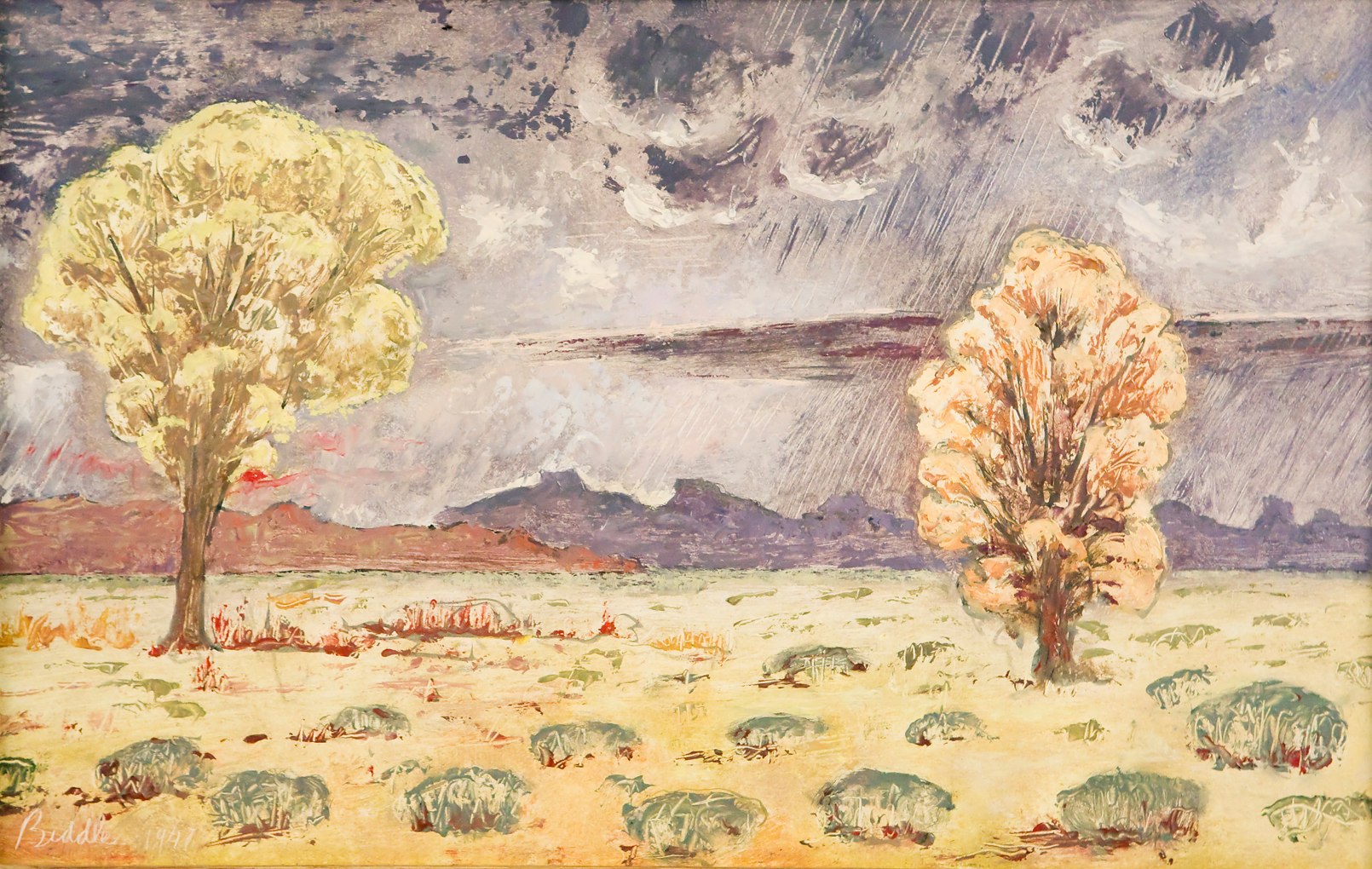
George Biddle (American 1885-1973)
Mesquite and Sycamore: Valley of the Virgin River, Utah, 1947
Oil on board
15 x 21 inches
SOLD
George Biddle, the founder of the WPA Federal Arts Program in the 1930s, was influenced by his circle of artist friends which included William Zorach, Elie Nadelman, Gaston Lachaise, and Diego Rivera. He became renowned as a muralist and painted scenes from his worldwide travels. On one of those journeys he experienced the stark beauty and drama of Utah’s desert country.
In Mesquite and Sycamore: Valley of the Virgin River, Utah, Biddle suggests the electric atmosphere of an incoming storm. A sycamore tree on the left, and a mesquite on the right, serve to frame the work and lead the viewer’s eye to the mountains in the background and the turbulent clouds above. The danger of flash floods lurks in the desert, charging the scene further. Biddle deftly used crosshatched brush strokes to suggest the approaching rain and ignite the sky with movement.
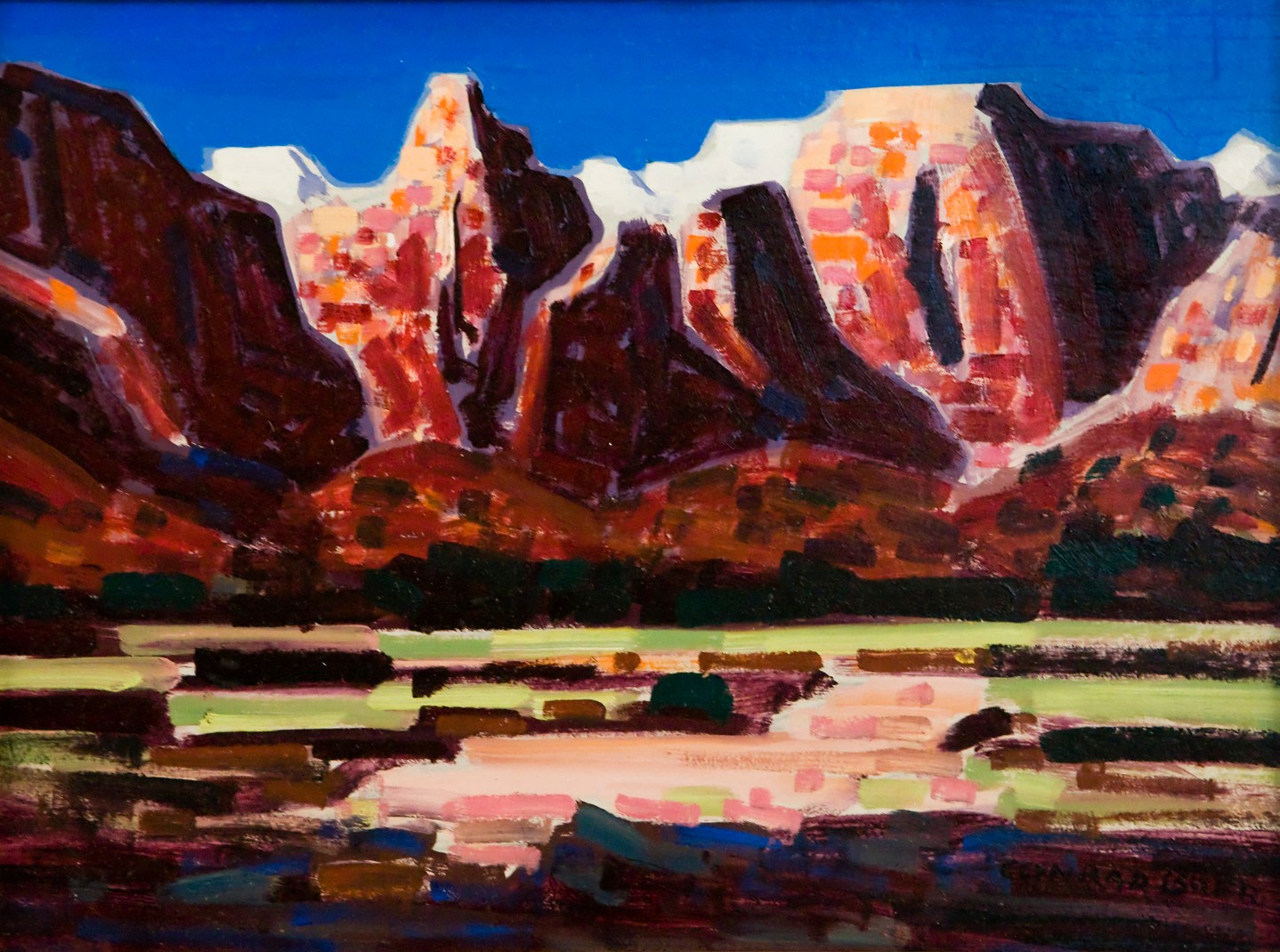
Conrad Buff (1886 - 1975)
Utah, circa 1960
Oil on board
11 x 15 inches
Buff employs broad, pointillist style technique to suggest the contours of the Virgin River coursing through Zion National Park. His dynamic and bold use of alternating colors and broad, energetic brush strokes creates a vivid image of the Three Sisters formation in Zion.
Biography:
Born and raised in the conservatism of nineteenth-century Switzerland, Conrad Buff spent a restless youth seeking an outlet for his artistic spirit. His talent would flourish in the majestic landscape and creative individualism of the American West. In the opening decade of the new century, his arrival in California coincided with the flowering of a dynamic movement in American art. Sketching and painting en plein air, Buff was inspired by the grandeur of the High Sierras and the drama of the wind-sculpted desert. In a long and prodigious career he bridged the coloration and brushwork of impressionism with the abstraction and structure of modern art. (Source: The Art and Life of Conrad Buff, by Libby Buff, George Stem, Will South) In the 1920s, a Los Angeles art critic wrote, “Conrad Buff comprehends the enormity of the West. More than that, he adds thereto a discernment of the stylized and conventionalized forms in which the West abound. Not one artist in a hundred grasps the significance of the West’s dynamic forms.”
